Exploiter no more: root metabolites driving denitrification inhibition from diverse plants
IF 10.3
1区 农林科学
Q1 SOIL SCIENCE
引用次数: 0
Abstract
Soil denitrifiers can profoundly benefit from plant root activities by utilizing the released labile carbon (C) in root exudates, though the plants may not receive direct benefits in return. However, the role of root metabolites in promoting or suppressing denitrification remains poorly understood across a wide range of plant species. Additionally, the underlying mechanisms driving these effects are still elusive. We used an optimized hydroponic-based approach to collect root metabolites in hydroponic solution from 100 plant species. We then assessed their differential effects on soil denitrification potential, microbial activity and the abundance of denitrification genes. Out of the 100 plant species tested, the root metabolites of 21 exhibited biological denitrification inhibition (BDI), while 51 stimulated denitrification under conditions of sufficient C supply. Some of the collected BDI root solutions inhibited soil denitrifying activity within the heterotrophic community and reduced the abundance of key denitrification genes, including nirK, nirS and nosZ. Several potential BDI-related secondary metabolites, such as flavonoids, were identified using untargeted LC–MS metabolomics. Our findings suggest that the inhibition of denitrification through root metabolites may be a widespread strategy among plant species, offering new insights for developing effective strategies to mitigate plant-mediated N losses in the rhizosphere.
不再是剥削者:来自不同植物的根代谢物驱动反硝化抑制
土壤反硝化物可以通过利用根系分泌物中释放的不稳定碳(C)从植物的根系活动中获益,尽管植物可能没有得到直接的回报。然而,根代谢物在促进或抑制反硝化作用中的作用在广泛的植物物种中仍然知之甚少。此外,驱动这些效应的潜在机制仍然难以捉摸。采用一种优化的水培方法,对100种植物的根代谢产物进行了水培试验。然后,我们评估了它们对土壤反硝化潜力、微生物活性和反硝化基因丰度的差异影响。在测试的100种植物中,21种植物的根代谢物表现出生物反硝化抑制(BDI),而51种植物在充足的C供应条件下促进反硝化。部分收集到的BDI根液抑制了异养群落内土壤反硝化活性,降低了关键反硝化基因nirK、nirS和nosZ的丰度。使用非靶向LC-MS代谢组学鉴定了几种潜在的bdi相关的次级代谢物,如类黄酮。我们的研究结果表明,通过根代谢物抑制反硝化可能是植物物种中普遍存在的一种策略,为开发有效的策略来减轻植物介导的根际氮损失提供了新的见解。
本文章由计算机程序翻译,如有差异,请以英文原文为准。
求助全文
约1分钟内获得全文
求助全文
来源期刊

Soil Biology & Biochemistry
农林科学-土壤科学
CiteScore
16.90
自引率
9.30%
发文量
312
审稿时长
49 days
期刊介绍:
Soil Biology & Biochemistry publishes original research articles of international significance focusing on biological processes in soil and their applications to soil and environmental quality. Major topics include the ecology and biochemical processes of soil organisms, their effects on the environment, and interactions with plants. The journal also welcomes state-of-the-art reviews and discussions on contemporary research in soil biology and biochemistry.
 求助内容:
求助内容: 应助结果提醒方式:
应助结果提醒方式:


